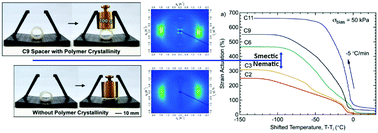High strain actuation liquid crystal elastomers via modulation of mesophase structure†
Abstract
Control of the mesophase in liquid crystalline elastomers (LCEs) is a critical aspect in harnessing their unique stimuli-responsive properties. Few studies have compared nematic and smectic main-chain LCEs in a direct way. Traditionally, it is believed that the mesogen core and synthetic route determines the phase behavior. In this study, we hypothesized that tuning the LC phases in main-chain LCE systems can be achieved by varying the spacer length while maintaining the same mesogen (RM257). By increasing the length of dithiol alkyl spacers containing two to eleven carbons along the spacer backbone (C2 to C11), we can modulate the mesophase from nematic to smectic, tailor the nematic to isotropic transition temperature between 90 and 140 °C, and increase the average work capacity from 128 to 262 kJ m−3. Phase nano-segregation resulting in the smectic C phase is achieved at room temperature for the C6, C9, and C11 spacers. In a shape switching system, this manifests in impressive actuation stroke of 700%. Upon heating from room temperature, these samples transition into the nematic and later, the isotropic phase. Furthermore, this segregation occurs along with polymer chain crystallinity, which increases the modulus of the networks by an order of magnitude; however, the crystallization rate is highly time dependent on the spacer length and can vary between 5 minutes for the C11 spacer and 24 hours for shorter spacers. This study presents several possibilities of a thiol–acrylate reaction in modulation of the thermomechanical and liquid-crystalline properties of LCEs and discusses their potential use for biomedical applications.

- This article is part of the themed collection: Liquid Crystal Elastomers


 Please wait while we load your content...
Please wait while we load your content...